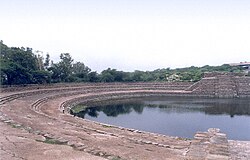Suraj Kund
| Surajkund सुरजकुण्ड |
|
|---|---|

View of Surajkund
|
|
| Location | Surajkund, Faridabad |
| Coordinates | 28°29′02″N 77°16′58″E / 28.48379°N 77.28270°ECoordinates: 28°29′02″N 77°16′58″E / 28.48379°N 77.28270°E |
| Type | Reservoir |
| Basin countries | India |
| Settlements | Faridabad |
| References | |
Surajkund (सुरजकुण्ड) is an ancient reservoir of the 10th century located in Faridabad about 8 km (5 miles) from South Delhi. Surajkund (literal meaning is 'Lake of the Sun') is an artificial Kund (‘Kund’ means "lake" or reservoir) built in the backdrop of the Aravalli hills with an amphitheatre shaped embankment constructed in semicircular form. It is said to have been built by the king Suraj Pal of Tomar dynasty in the 10th century. Tomar was a sun worshipper and he had therefore built a Sun temple on its western bank.
Another 'kund' by the same name as ‘Suraj Kund’ existed in Sunam city, tahsil and sub-division of the Sangrur District in Punjab. This was sacked by Mahmood Ghaznvi or Taimur Lane. The temple is now in ruins.
Place is known for its annual fair "Surajkund International Craft Mela", 2015 edition of this fair was visited by 1.2 million visitors including 160,000 foreigners with more than 20 countries participating in it.
Surajkund is located near the Surajkund village between the villages of Baharpur and Lakkarpur in Faridabad district of Haryana. The lake's drainage basin is part of the Aravalli hill ranges. It is fed from the north western side by a local nallah (stream) that initially feeds the Anagpur dam on the upstream.
The storage in the tank or lake has been seriously affected since the catchment area contributing flows into the Surajkund (lake) from villages such as Anangpur, Lakkarpur, Ankhir and Meola Maharajpur has been used for extensive mining and for large habitations, which has disturbed the drainage system and thus obstructed the gravity flow of rain water from the basin into the reservoir. This situation is stated to have also affected the flora and fauna of the area.
In the Aravalli hill ranges, which spreads over Delhi and Haryana, where the Surajkund and the Anagpur Dam are located, ancient Stone Age relics have been revealed. The Aravallis, which strike out in two directions from Delhi exhibits a topography of low and rugged hills. The stratigraphy in the area is considered to consist of reddish rocks and scrub and has the luxuriance of the Stone Age progression. Stone Age material have been unearthed in the region at 43 sites on the road from Delhi to Surajkund and south of the Suraj Kund-Faridabad road, Anangpur hills and Ankhir pahari on the road on the low ridge from Faridabad to Surajkund. The Stone Age relics comprise Microliths and lower Paleolithics.
...
Wikipedia
